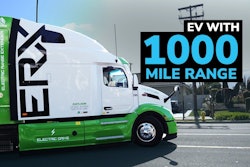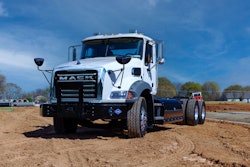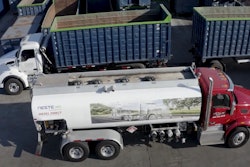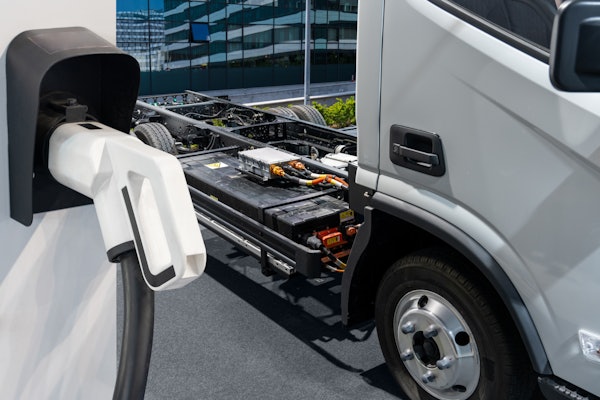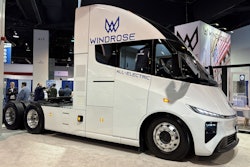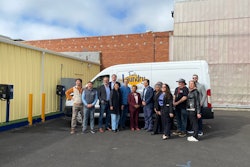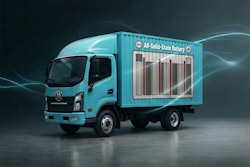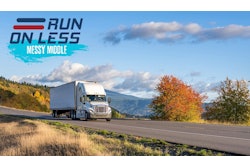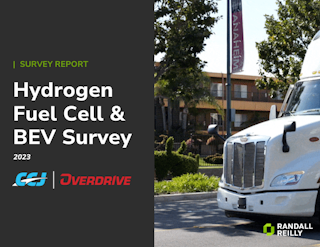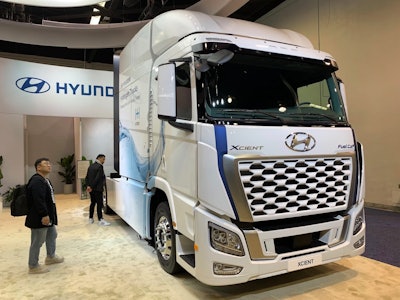
Internal combustion, all-electric and hydrogen fuel cell…the road to zero emissions is being built with some very familiar technologies and some all new at least for Class 8 trucks where capability plays a critical role among thin profit margins.
 Achates Power CEO and President Dave Crompton explained that their near-zero 10.6-liter opposed piston engine is a cost-cutting alternative to cylinder deactivation and more complex aftertreatment. “We’re going to use conventional aftertreatment so you don’t need heated urea. You don’t need dual dosing. You don’t need cylinder deactivation. All those things are going to add cost and complexity." According to the Truck and Engine Manufacturing Association, modifying existing four-stroke diesels to meet CARB's 2027 standard will increase truck cost greater than $30,000.Achates Power
Achates Power CEO and President Dave Crompton explained that their near-zero 10.6-liter opposed piston engine is a cost-cutting alternative to cylinder deactivation and more complex aftertreatment. “We’re going to use conventional aftertreatment so you don’t need heated urea. You don’t need dual dosing. You don’t need cylinder deactivation. All those things are going to add cost and complexity." According to the Truck and Engine Manufacturing Association, modifying existing four-stroke diesels to meet CARB's 2027 standard will increase truck cost greater than $30,000.Achates Power
First up…the internal combustion engine (ICE) is not dead. Far from it. The nation’s most popular powertrain has made great strides in cutting emissions and continues to do so.
“Internal combustion engines aren’t going to disappear anytime soon,” said Diesel Technology Forum Executive Director Allen Schaeffer. “Our most recent analysis of the trucking fleet population says that 99.8% of all commercial trucks today are powered by an internal combustion engine. I don’t see a future powertrain market that looks like a hockey stick graphic that some are talking about where suddenly the numbers work out and a BEV is more economical than a diesel to own and operate and ‘Presto!’ everyone shifts to that.
“There is no doubt that some market share of diesel and natural gas engines will be taken by ZEV (zero-emission vehicle) technologies in the coming years,” Schaeffer continued. “I think it will happen in niches and segments and in fits and starts. It will be as uneven as it is unpredictable, largely due to the incredible challenge of putting an entirely new infrastructure in place for fueling. Whether that is HD charging networks or H2 fueling capacity.”
All-electric for the short haul
OEMs have continued to roll out all-electric Class 8 tractors which continue to show improvements in both range and charge times.Tesla reports that its Semi has the longest range of all at 500 miles. Other electric tractors are advertised below 300 miles. No matter the range, the extra weight brought on by large batteries eats into payload and invites a waiver allowing for an extra 2,000 lbs. for a max 82,000 lb. gross vehicle weight.
 Volvo Trucks advertises their VNR Electric with an improved range of 275 miles and a 90-minute DC fast charge to bring the battery to 80% capacity.Volvo Trucks North America
Volvo Trucks advertises their VNR Electric with an improved range of 275 miles and a 90-minute DC fast charge to bring the battery to 80% capacity.Volvo Trucks North America
Driver feedback has been generally positive particularly around handling, quick acceleration, quiet performance and one-pedal driving. One-pedal driving is possible through an EV’s regenerative braking system. Drivers simply lift up their foot from the accelerator while brake regen engages to help charge the batteries while slowing the vehicle down. Brake regen settings can vary with some offering more charging power but at the price of harsher braking. Knowing how much to back of the pedal is key and can prove to be an engaging challenge for drivers who can see on the dash how much power their recouping while slowing the truck down.
Charge times vary in EVs depending on battery size and charger capabilities. Kenworth reports that its “T680E uses a CCS1 DC fast charger with maximum rate of 150 kW and just over 3 hours charging time.”
Given tedious paperwork trails, supply chain issues and the sometimes necessary buildout of electric infrastructure, estimated time to install an electric truck charger is currently about 18 months.
California passed legislation to streamline the application process across jurisdictions there but not all local municipalities have transitioned to the new approach according to Niki Okuk, deputy director of fleet engagement & community outreach at CALSTART.
Fleets looking to more quickly secure chargers may be better off with portable chargers like the fuel cell powered Mobile Power Generation System from GM's Hydrotec. GM uses the hydrogen fueled charger at events where power is needed to charge their growing lineup of EVs including their 2024 Silverado EV.
Shopping for chargers and EVs can be challenging. To that end, CALFLEET recently rolled out Cal Fleet Advisor to help fleets and owner-operators transition to zero-emission vehicles ranging from Class 2b through Class 8. CALFLEET has since helped to bring that advisory model to Massachusetts.
Okuk stressed the importance of fleets first meeting with their utilities to determine power needs relative to the current power supply. Utilities will play critical roles in installing chargers and supporting equipment.
Utilities may also offer vehicle-to-grid (V2G) programs allowing customers to sell back unused electricity from an idle EV. This can prove more advantageous for fleets during peak use times which occur during the day when power demands are highest. Vehicle-to-building (V2B) scenarios are also possible whereas an EV can provide power to a home or office during a power outage.
Battery chemistry plays an important role when it comes to EV selection. More manufacturers have been switching to lithium iron phosphate (LFP) which provides greater stability over conventional lithium-ion which can be subject to thermal runaway events when packs are compromised in a collision for instance. Newer LFP batteries have been closing the gap on energy density, an advantage enjoyed by lithium-ion.
Batteries can be used in stationary energy storage applications once they reach about 80% degradation or the point at which they're no longer suitable for powertrain use. Dependable Highway Express in Ontario, California has a solar-powered charging system that will eventually use batteries from their Volvo VNR Electrics once the trucks can no longer provide adequate range. Those batteries will be charged by solar during the day and then used overnight to charge other electric trucks. In the meantime, DHE is using other batteries to get more acclimated with the system as it charges their trucks overnight.
Battery recycling will have to be considered following second-life use cases. Depending on an EV’s duty cycle and charging habits, that may be 10 to 15 years down the road following EV purchase. The elements batteries contain like nickel, cobalt and manganese fluctuate in price and may make recycling more appealing when the time comes.
Fleets wishing to steer clear of battery lifecycle management and other tasks relative to EV ownership may want to opt for vehicle leasing instead. More EV-as-a-service models have emerged which remove vehicle care, service and charging from the fleet.
Fuel cell for the longer haul
Though they may evoke thoughts of a fascinating science project, hydrogen fuel cell trucks are steadily gaining ground in the trucking industry thanks largely to their longer ranges and faster refueling times over all-electric.While fuel cell trucks are rolling out in the U.S., they’re enjoying greater popularity in Europe where Volvo Trucks reports a range of up to 620 miles and a refill time of less than 15 minutes. Volvo and Daimler AG founded Cellcentric in 2021 to jointly produce fuel cells.
 Department of Energy
Department of Energy
But as Schaeffer notes above, hydrogen fueling infrastructure is a challenge—a big challenge. The DOE alt fuel station map shows only 57 hydrogen stations in the country all of which are in California and not all are available to refuel fuel cell trucks.
Nonetheless, players in the space including iconic powertrain manufacturer Cummins and newcomers like Nikola remain bullish on hydrogen and envision more stations coming online to meet demand.
In late 2020, Cummins reported on its three hydrogen production facilities including a 20-megawatt plant in Canada capable of annually producing 3,000 tons of hydrogen.
Nikola, through its subsidiary hydrogen fueling company Hyla, plans on rolling out 50 stations over the next five years throughout North America with business partner Voltera.
Help from the Inflation Reduction Act includes a 10-year production tax credit for green hydrogen facilities.
While the DOE credits fuel cells with having up to “two times the efficiency of traditional combustion technologies,” the technology has historically been expensive. A fuel cell truck can cost twice that of an all-electric model.
Progress continues to be made in bringing costs down and improving efficiency. Hyzon announced in May that when compared to stacking two of its 100kW fuel cells (stacking fuel cells is a common practice), its single stack 200kW fuel cell offered a 30% reduction in total volume; 25% reduction in total fuel cell system manufacturing costs; a 30% reduction in total weight; and a 20% estimated increase in miles driven per kg of hydrogen.
Fuel cell longevity also continues to improve. Stanford’s Precourt Institute for Energy reported that three AC Transit buses powered by fuel cells “had exceeded 30,000 service hours without any major repairs or rehab maintenance.”
Toyota's fuel cell technology in its passenger car Mirai which has been used to power Kenworth's T680 FCEV (fuel cell electric vehicle) has proven to be a durable fit for the past eight years it's been on the road.
"We have had our light-duty Mirai in the market since 2015 in California, and the overall reliability of those vehicles has been great," said Jackie Birdsall, Toyota's senior engineering manager of fuel cell development. "To this point we have not made production powertrain kits for HD trucks (we plan to begin production later this year) so we cannot provide specific in-market feedback, but since the technology is a scaled version of our light-duty powertrain we believe it will absolutely meet the demand for its intended application."
Operational costs for fuel cell vehicles however remain high. Stanford's study shows that the average cost of energy per mile for AC Transit’s fuel cell buses exceeded all-electric by 223% and diesel by 297% over a six-month time frame. The cost of maintenance per mile pushed fuel cell 43% above electric and 139% over diesel.
Birdsall pointed out that fuel cell vehicles are essentially electric vehicles with an onboard generator. Fewer battery cells are needed than all-electric and thus encroach less on payload. As with all-electric, battery lifecycle management should be kept in mind.
"Compared to batteries, hydrogen is an effective fuel for applications requiring long range, demanding duty cycles with minimum downtime," Birdsall said. "Hydrogen can be stored, allowing for higher energy storage than batteries at a fraction of the weight."
 Diesel fuel and maintenance costs were the lowest when compared to other alt fuel buses at AC Transit in Northern California.Stanford Precourt Insitute for Energy
Diesel fuel and maintenance costs were the lowest when compared to other alt fuel buses at AC Transit in Northern California.Stanford Precourt Insitute for Energy
Diesel gets greener with biofuels
On its website, Diesel Technology Forum notes that “diesel is the most energy-efficient internal combustion engine” and has reached “near-zero emissions with increasing fuel efficiency and lower CO2 emissions, and further improvements are now on the horizon.”DTF points out that low-carbon renewable biofuels also play a role in reducing greenhouse gas (GHG) emissions.
Fleets are increasingly turning to low carbon biofuels like renewable diesel and biodiesel both of which are gaining market share beyond California where those fuels have long been supported by generous subsidies.
DOE currently shows 1,243 biodiesel stations across the country while renewable diesel can be found at 577 stations, nearly all of which are in California save for six in Oregon.
Carrie Song, North American vice president of Renewable Road Transportation at Neste, the world’s largest producer of renewable diesel, said renewable diesel expansion hinges on expanding subsidies. The Inflation Reduction Act will help by extending the $1 per gallon biomass-based diesel blender's tax credit until Dec. 31, 2024.
Finland-based Neste has watched interest grow in its MY Renewable Diesel in the U.S. which is promoted with a GHG reduction up to 95% over conventional diesel. A cetane value ranging from 75 to 85 is quite a step up as well and helps to reduce emissions while improving fuel economy through more efficient combustion.
“It's really getting popular in the U.S.,” said Song said. “You see the level of investment and announcements on biofuels in general, whether that's renewable diesel or sustainable aviation fuel. There are lots of things going on in the U.S.”
Biofuels and spark-ignited ICE
Beyond diesel, the internal combustion engine continues to turn heads with improved technologies and green gaseous fuels like renewable natural gas, renewable propane, renewable gasoline, green hydrogen and ethanol.Renewable natural gas is the cleanest of all transportation fuels according to the California Air Resources Board and the Environmental Protection Agency with a current carbon intensity score of -600. RNG gets its negative carbon score since it’s derived from methane which is considered to be a much more destructive to the ozone layer than other transportation-related gases like carbon dioxide.
 How green is your fuel? Running cleaner means more than just choosing the right powertrain. Renewable natural gas has the lowest carbon intensity value putting it clearly ahead of electric and hydrogen according to the California Air Resources Board.CARB
How green is your fuel? Running cleaner means more than just choosing the right powertrain. Renewable natural gas has the lowest carbon intensity value putting it clearly ahead of electric and hydrogen according to the California Air Resources Board.CARB
Renewable gasoline is produced from biomass sources like plant and vegetable oils and is currently blended with gasoline in California according to CARB.
Green hydrogen is produced from clean energy sources like solar, wind and hydroelectric power. According to the National Renewable Energy Laboratory, most hydrogen is produced by “steam reforming natural gas. But natural gas is already a good fuel and one that is rapidly becoming scarcer and more expensive.”
Renewable natural gas (RNG) proponents including Cummins contend that RNG supply levels are not under threat and that the methane used to produce the carbon negative fuel remains abundant at landfills, waste water treatment facilities and dairy farms. Hydrogen produced from RNG "can significantly reduce greenhouse gas emissions and minimize environmental pollution" hydrogen production and storage supplier BayoTech notes on its website.
Cummins revealed its 15-liter hydrogen engine last year which the company says can be refilled in 10 to 15 minutes and provide up to 500 miles of range. Carbon dioxide is virtually eliminated and NOx is cut by up to 75%. The European Union is considering legislation that would classify hydrogen engines as zero emissions while CARB and the EPA have rejected the notion since trace amounts of crankcase oil are combusted with hydrogen and thus produce a small amount of emissions.
Ethanol, an alcohol-based fuel, has long been blended in gasoline to varying degrees (mostly at 10%) and can be carbon neutral according to CARB depending on fuel sources and production methods.
ClearFlame, a Chicago-based startup, gained notable support after converting diesel engines to run on E98 ethanol. That nearly pure grade of ethanol is available at fuel distributors around the country and can provide fleets with a quick 45% reduction in carbon dioxide, a 90% drop in NOx and a 99% decline in particulate matter compared to diesel. ClearFlame also reports that E98 can save fleets 40 cents per mile.
Schaeffer sees biofuels more quickly and easily cutting emissions versus nascent zero-emission powertrains that have little infrastructure in place.
“We make a big mistake by discounting the significant opportunity of just changing the fuel for internal combustion engines to something more renewable and low carbon -- and what that could mean for rapid decarbonization,” Schaeffer said. “If I could just change the fuel for a million trucks overnight and the next day and every following day they would have 50 percent or more fewer GHG emissions, that would put us farther ahead and faster on GHG reduction progress than we will get by the time the ZEV technology and its infrastructure gets more built out and available maybe 5 or 10 years later. Lots of feelings that that Administration doesn’t play technology neutral in its settings of renewable fuel volumes.”

